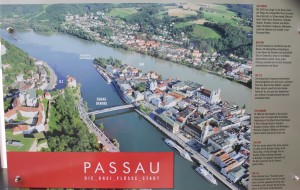Seniors Enjoy Vibrant Passau
Passau, in Lower Bavaria, Germany, is known as the Dreiflüssestadt or “City of Three Rivers.” The Danube is joined at Passau by the Inn River from the south and the Ilz from the north. Senior visitors will hear the saying that Passau is located on the Blue Danube, the Green Inn and the Black Ilz. Water has quite literally shaped this picturesque town on the border with Austria.
Passau lies in Germany’s far southeast corner. Settled since prehistory and a former hub of the salt trade (Europe’s ‘white gold’), it became the Roman village of Batavis, then later the Holy Roman Empire’s largest diocese and a sword-making center.
Passau is close to the Czech Republic and Austria with throngs of tourists arriving from these countries and from river cruises. Passau is also a popular holiday destination for Germans. About a fifth of the town’s population of 50,000 are students at the University of Passau, renowned for its Economics, Law, Theology and Computer Science institutes.
It is no surprise that Passau is the economic, cultural, and communications center of south-eastern Bavaria. Senior visitors discover city and state libraries, a municipal theater, and a host of other cultural institutions. Industries in Passau include a bell foundry, brewing, and the manufacture of optical instruments, textiles, and tobacco.
Fortress, Cathedral and Town Hall Draw Senior Visitors
The town is dominated by the Veste Oberhaus fortress. Sitting on the hill across the river from Passau old town, it was built by the prince-bishops to watch over the commerce in the rivers. The site is now the home of the Oberhaus Museum and from here there are panoramic views of Passau and the Danube.
The magnificent St. Stephen’s Cathedral, with its three characteristic green onion-domed towers, is a major highlight. Located on the highest point of the Old Town, the site incorporates the remains of an earlier Gothic structure. The Cathedral is home of the world’s second-largest cathedral organ.
Architect Carol Lurago created a cathedral filled with light and splendid architectural details. In Passau’s Gothic Town Hall there are paintings which depict episodes in the town’s past, including its association with the Nibelungen legends. The Altes Rathause (Old Town Hall) is another highlight of the city that dates from the fourteenth and fifteenth centuries. It’s neo-Gothic tower can be seen from all over town.
Historically, Passau was once the Celtic settlement of Bojodurum, and it later became the site of a Roman camp, Castra Batava. It was made an episcopal see in 739 and in 1217, the bishops became princes of the Holy Roman Empire. In spite of revolts by its citizens for municipal freedom, the prince-bishops managed to rule Passau until 1803.
You will find plenty to see and do in Passau so plan on spending a few days just enjoying one of Germany’s featured cities. jeb




